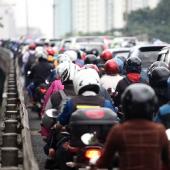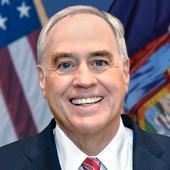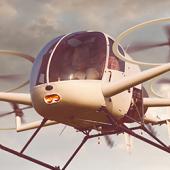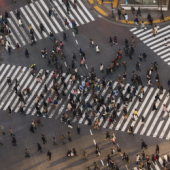Flying taxis and digital twin cities
IN BRIEF
- Flying taxis will be in the U.S. by 2028. Asia and Europe are far along on this; the UK is currently building its first “verti port” (vertical port) and Germany is going to roll one out next year. The U.S. isn't far behind.
- There are some big tech companies developing “digital twin” technology, and the conventional wisdom is that by 2025, lots of communities will be working with digital twins.
- The hope is that planning would lead to more equitable cities in 2030 and beyond.
Petra Hurtado is the Research Director at the American Planning Association (APA), heading APA’s research programs and foresight practice, where she’s responsible for expanding a future-focused research agenda and advancing planning practices that assist communities in navigating change. Her areas of expertise and research include urban sustainability, smart cities, emerging technologies, nature-based solutions, and environmental psychology. Hurtado sat down with VISION by Protiviti’s Editor-in-Chief Joe Kornik to discuss where she sees cities heading in 2030 and beyond.
Kornik: I’ve read quite bit about how the pandemic was maybe the beginning of the end of cities. Are cities in real trouble?
Hurtado: I know there’s been a lot of talk about that how this is the end of the city, because now people can just move wherever they want, and work remotely, and how cities haven’t been able to adjust quickly enough. But, you know, there’s more to cities than just work and job availability. Cities have been around for a long time, and they’ve gone through many pandemics, and many changes because of pandemics, and they’ve survived—and thrived. There’s a reason people like to live in cities: They want a sense of community; and they want to be a part of the experience of a city. Often, it’s an experience you can’t find elsewhere. So, I think cities will adjust and will be just fine post-COVID.
Kornik: Do you view COVID as a reset? Do you think they will be vastly different places when we get back to “normal”?
Hurtado: You know, to be honest, I hope they are different. It would be stupid, frankly, if we went back to the way they used to be because we’ve became aware of deficiencies in cities because of COVID. We have an opportunity to make some big changes. COVID highlighted many of the inequalities not everyone might have been aware of—people of color, for instance, were more negatively impacted by the pandemic. Their neighborhoods are often close to heavy industry and highways where the air is already polluted, which leads to conditions like asthma. Obesity rates tend to be higher because of the lack of healthy food options; and these are all planning issues that became more in focus because of COVID. We also saw how transportation behavior changed, especially during the lockdowns. We saw that it’s possible to mitigate climate change by reducing greenhouse gas emissions. For the longest time, there was the assumption that behavior could never change, but COVID showed us it could. That’s one bright spot from the pandemic.
Kornik: Has COVID helped open planners’ eyes or have planners known these things all along?
Hurtado: It’s probably a mix of both. I think we’ve tried to resolve a lot of the challenges with the same tools that created them, which is never a good approach. One of the APA’s roles is to research emerging trends and try to verify them with data to make sure some aspect is not just the latest fad or just something the media is talking about, but really verifying which trends will have high impacts in the future, which will result in disruption.
Kornik: What are some of those trends and disruptors you’re seeing right now?
Hurtado: One is drone technology and what that could mean for moving things—and people—around cities. Amazon and other delivery services are already piloting drone deliveries, but now we’re also talking about passenger transportation—flying taxis. This is a topic that has been discussed since the 1960s, and there was always this momentum where we thought it was going to happen and then it didn’t. OK, with the drone technology we currently have, this time it’s going to happen, for sure. We’re confident it’ll be here by 2028. Asia and Europe are far along on this; the UK is currently building its first “verti port” (vertical port) for flying taxis and Germany is going to roll one out next year. The U.S. is also trying to figure this out. The World Economic Forum is currently working on a blueprint with the city of Los Angeles on urban air mobility, and they have created the first set of policy recommendations, where things like safety, costs, noise pollution and verti port locations are being assessed. Planners need to be ahead of the policy. We need to embrace that disruption—use it to our advantage even. The emergence of Uber and Lyft disrupted cities to some extent and that’s not even a big innovation. Well, how much will air taxis disrupt cities? Probably a great deal. And speaking of Uber and Lyft, they are both in this air taxi space, as well.
I know there’s been a lot of talk about that how this is the end of the city, because now people can just move wherever they want, and work remotely, and how cities haven’t been able to adjust quickly enough.
Kornik: What are some other ways planners can use big data?
Hurtado: We can measure how people move around cities, for example. That data is being used to make decisions about urban planning. There’s this whole idea around what we call “digital twin” cities. Planners can work with real-time data, create a twin of a city and then use that to experiment and try things out before it would ever get implemented. There are some big tech companies developing this technology and the conventional wisdom is that by 2025, lots of communities will be working with digital twins. Creating a digital version of Chicago with all the relevant data, for instance, would give planners access to information and the ability to experiment on the impacts of policy changes. If we build this road, how will that impact our greenhouse gas emissions. That level of experimentation hasn’t been available to planners before now and it will drastically alter the way city planning is done, and cities themselves, over the next several years.
Kornik: Will cities be better places to live in 2030 and beyond?
Hurtado: All the developments we’ve just talked about becoming a reality are going to disrupt cities tremendously… things like autonomous vehicles and flying taxis and digital twins, you name it. But I also think there are so many dynamic things happening right now that you don’t even have to go that far out to envision the changes coming. Look at all the discussions we’re having around people and equity right now; well, urban planning contributed to these inequalities that we’re seeing today in cities. It would be great if we learned from some of those mistakes. So, if I could make one wish it would be that planning would lead to more equitable cities in 2030 and beyond.
There’s this whole idea around what we call “digital twin” cities. Planners can work with real-time data, create a twin of a city and then use that to experiment and try things out before it would ever get implemented.
Did you enjoy this content? For more like this, subscribe to the VISION by Protiviti newsletter.




































